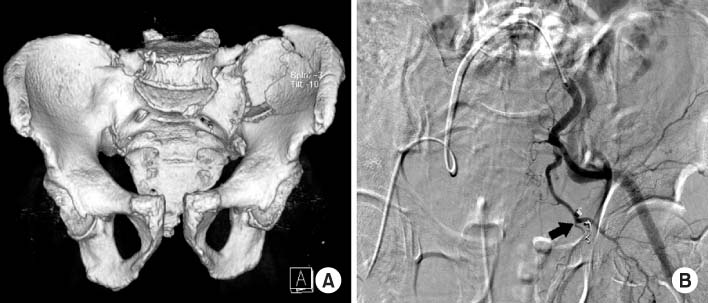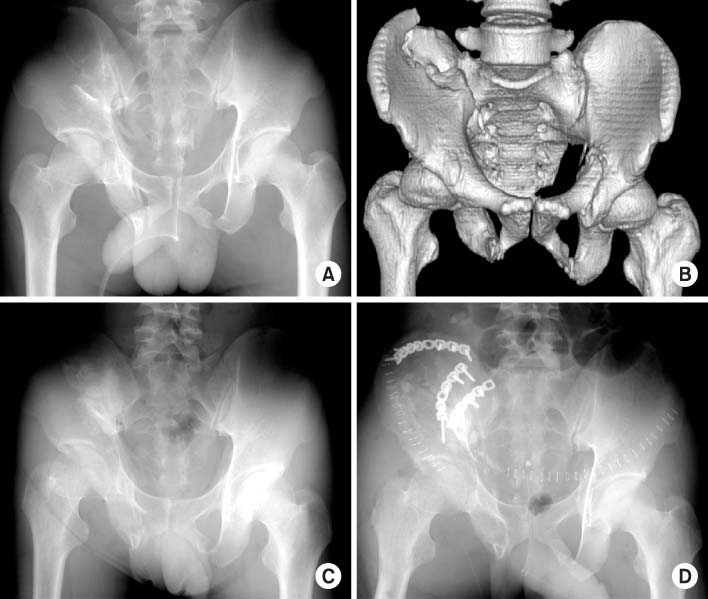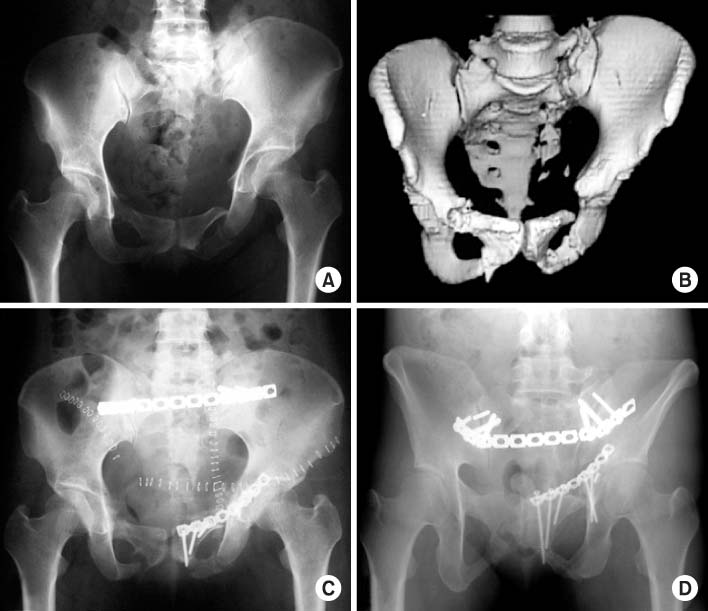J Korean Fract Soc.
2013 Oct;26(4):348-353. 10.12671/jkfs.2013.26.4.348.
Complications of Pelvic Ring Injury
- Affiliations
-
- 1Department of Orthopedic Surgery, Keimyung University School of Medicine, Daegu, Korea. min@dsmc.or.kr
- KMID: 2183839
- DOI: http://doi.org/10.12671/jkfs.2013.26.4.348
Abstract
- No abstract available.
Figure
Reference
-
1. Buerger PM, Peoples JB, Lemmon GW, McCarthy MC. Risk of pulmonary emboli in patients with pelvic fractures. Am Surg. 1993; 59:505–508.2. Burgess AR, Eastridge BJ, Young JW, et al. Pelvic ring disruptions: effective classification system and treatment protocols. J Trauma. 1990; 30:848–856.3. Colapinto V. Trauma to the pelvis: urethral injury. Clin Orthop Relat Res. 1980; (151):46–55.
Article4. Denis F, Davis S, Comfort T. Sacral fractures: an important problem. Retrospective analysis of 236 cases. Clin Orthop Relat Res. 1988; 227:67–81.5. Griffin DR, Starr AJ, Reinert CM, Jones AL, Whitlock S. Vertically unstable pelvic fractures fixed with percutaneous iliosacral screws: does posterior injury pattern predict fixation failure? J Orthop Trauma. 2003; 17:399–405.
Article6. Grotz MR, Allami MK, Harwood P, Pape HC, Krettek C, Giannoudis PV. Open pelvic fractures: epidemiology, current concepts of management and outcome. Injury. 2005; 36:1–13.
Article7. Hak DJ, Olson SA, Matta JM. Diagnosis and management of closed internal degloving injuries associated with pelvic and acetabular fractures: the Morel-Lavallée lesion. J Trauma. 1997; 42:1046–1051.
Article8. Kellam JF, McMurtry RY, Paley D, Tile M. The unstable pelvic fracture. Operative treatment. Orthop Clin North Am. 1987; 18:25–41.9. Kiely N, Williams N. Sexual dysfunction in women following pelvic fractures with sacro-iliac disruption. Injury. 1996; 27:45–46.
Article10. Kurylo JC, Tornetta P 3rd. Initial management and classification of pelvic fractures. Instr Course Lect. 2012; 61:3–18.11. Matta JM, Dickson KF, Markovich GD. Surgical treatment of pelvic nonunions and malunions. Clin Orthop Relat Res. 1996; (329):199–206.
Article12. Matta JM, Saucedo T. Internal fixation of pelvic ring fractures. Clin Orthop Relat Res. 1989; (242):83–97.
Article13. Matta JM, Tornetta P 3rd. Internal fixation of unstable pelvic ring injuries. Clin Orthop Relat Res. 1996; (329):129–140.
Article14. Moed BR, Geer BL. S2 iliosacral screw fixation for disruptions of the posterior pelvic ring: a report of 49 cases. J Orthop Trauma. 2006; 20:378–383.
Article15. Moed BR, Karges DE. Techniques for reduction and fixation of pelvic ring disruptions through the posterior approach. Clin Orthop Relat Res. 1996; (329):102–114.
Article16. O'brien DP, Luchette FA, Pereira SJ, et al. Pelvic fracture in the elderly is associated with increased mortality. Surgery. 2002; 132:710–714.17. Oxford CF, Stein A. Complicated crushing injuries of the pelvis. J Bone Joint Surg Br. 1967; 49:24–32.18. Pennal GF, Massiah KA. Nonunion and delayed union of fractures of the pelvis. Clin Orthop Relat Res. 1980; (151):124–129.
Article19. Rai SK, Far RF, Ghovanlou B. Neurologic deficits associated with sacral wing fractures. Orthopedics. 1990; 13:1363–1366.
Article20. Routt ML Jr, Kregor PJ, Simonian PT, Mayo KA. Early results of percutaneous iliosacral screws placed with the patient in the supine position. J Orthop Trauma. 1995; 9:207–214.
Article21. Ruedi TP, Buckley R, Moran CG. AO principles of fracture management. Davos Platz: George Thieme Verlag;2007.22. Tile M, Helfet DL, Kellam JF. Fractures of the pelvis and acetabulum. 3rd ed. Philadelphia: Lippincott Williams & Wilkins;2003.23. Tornetta P 3rd, Matta JM. Outcome of operatively treated unstable posterior pelvic ring disruptions. Clin Orthop Relat Res. 1996; (329):186–193.
Article24. Tseng S, Tornetta P 3rd. Percutaneous management of Morel-Lavallee lesions. J Bone Joint Surg Am. 2006; 88:92–96.
Article




